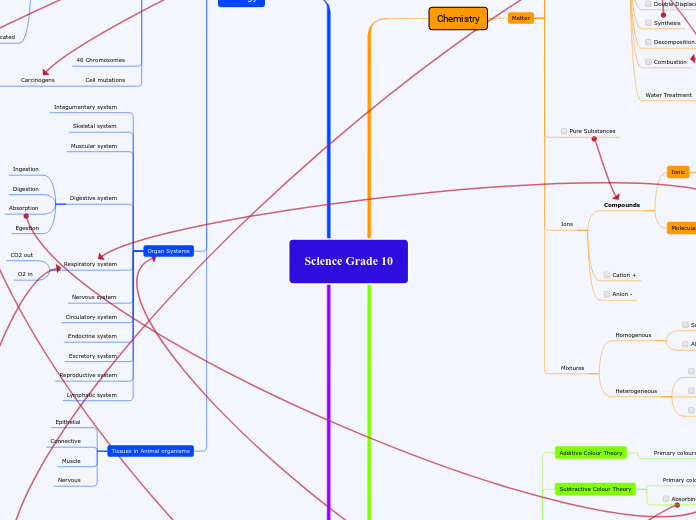Science Grade 10
Chemistry
Matter
Elements
Atoms
Protons
Neutrons
Electrons
Equations
Word
Skeleton
Balance
Chemical Reactions
Acid
Base
WHIMIS Symbols
Biohazard
Long term heath hazard
toxic hazard etc
Chemical Change
New colour
Hard to reverse
Sound
Gas
Vaporization
Precipitate
Law of Conservation of Mass
Single Displacemnet
Double Displacement
Synthesis
Decomposition
Combustion
Water Treatment
Neutralization
UV light used as well
Pure Substances
Ions
Compounds
Ionic
Polyatomic Ions
Binary
Multivalent
Molecular
CO2
Diatomic Molecules
Non metal + Non metal
Covalent bond
Cation +
Anion -
Mixtures
Homogenous
Solutions
Alloys
Heterogeneous
Colloid
Mechanical Mixture
Suspension
Physics
Color
Additive Colour Theory
Primary colours
Red, Green, Blue
Subtractive Colour Theory
Primary colours
Cyan, Yellow, Magenta
Absorbing and Reflecting Colour Rays
Visible Colour spectrum
Red, orange, yellow, green, blue, indigo, violet
The eye
Retina detects colour
The lens is convex
Car side mirrors are convex
Image is smaller
Telescope lenses are concave
A magnifying glass converges light
You can create a fire by using one and holding it so the suns rays converge and create heat.
Light
Wavelengths
Crest
Tough
Resting Position
Amplitude
Radio Wave
Microwave
Infared
Visible
Ultraviolet
X Ray
Gamma Ray
Incandescent
Fluorescent
Phosphorescence
chemiluminescence
Triboluminescence
Light from electron discharge
Electroluminescent light
Law of Reflection
Sunlight - Infrared, visible, Ultraviolet
Biology
Cells
Plastids, Chloroplast, Cell Wall, Vacuole
Photosynthesis
H2O + CO2 + Sunlight -> Sugar + O2
Plant Cell
Cell Membrane
Chloroplast
Cytoplasm
Ribosomes
Vesicles
Golgi Apparatus
Mitochondria
Endoplasmic Reticulum
Nuclear Membrane
Nucleus
Nucleolus
Plant Tissues
Meristematic
Epidermal
Ground
Vascular
Animal Cell
Centrioles
Lysosomes
Stem Cells
Embryonic
Umbilical
Adult
Cell Division
Mitosis
Interphase
Prophase
Metaphase
Anaphase
Telephase
Cytokinesis
2 identical nuclei are created and divide like cytoplasm
A nuclear membrane is created for each daughter chromosome
The spindle fibres pull apart the centromeres
Spindle fibres attach and pull the centromeres
Chromosomes visible
DNA duplicated
46 Chromosomes
Cell mutations
Carcinogens
Radiation
Viruses/pathogens
Organ Systems
Integumentary system
Skeletal system
Muscular system
Digestive system
Ingestion
Digestion
Absorption
Egestion
Respiratory system
CO2 out
O2 in
Nervous system
Circulatory system
Endocrine system
Excretory system
Reproductive system
Lymphatic system
Tissues in Animal organisms
Epithelial
Connective
Muscle
Nervous
Climate Change
Greenhouse Effect
Natural
Water vapor
Carbon Cycle
Humans and animals release carbon
Water and plants absorb CO2
Carbon goes in the ground when living things die.
Methane in low O2 areas
Nitrogen Cycle
Atmosphere moderate Temperatures
Anthropogenic
Sources
Vehicles
Factories
Sink
Plants
Ocean/water
Albedo
How much of the suns radiation is reflected back to space
Concrete - 17-27%
Water bodies - 10-60%
Snow - 80-95%
Spheres of the Earth
Atmosphere
Hydrosphere
Lithosphere
Biosphere
